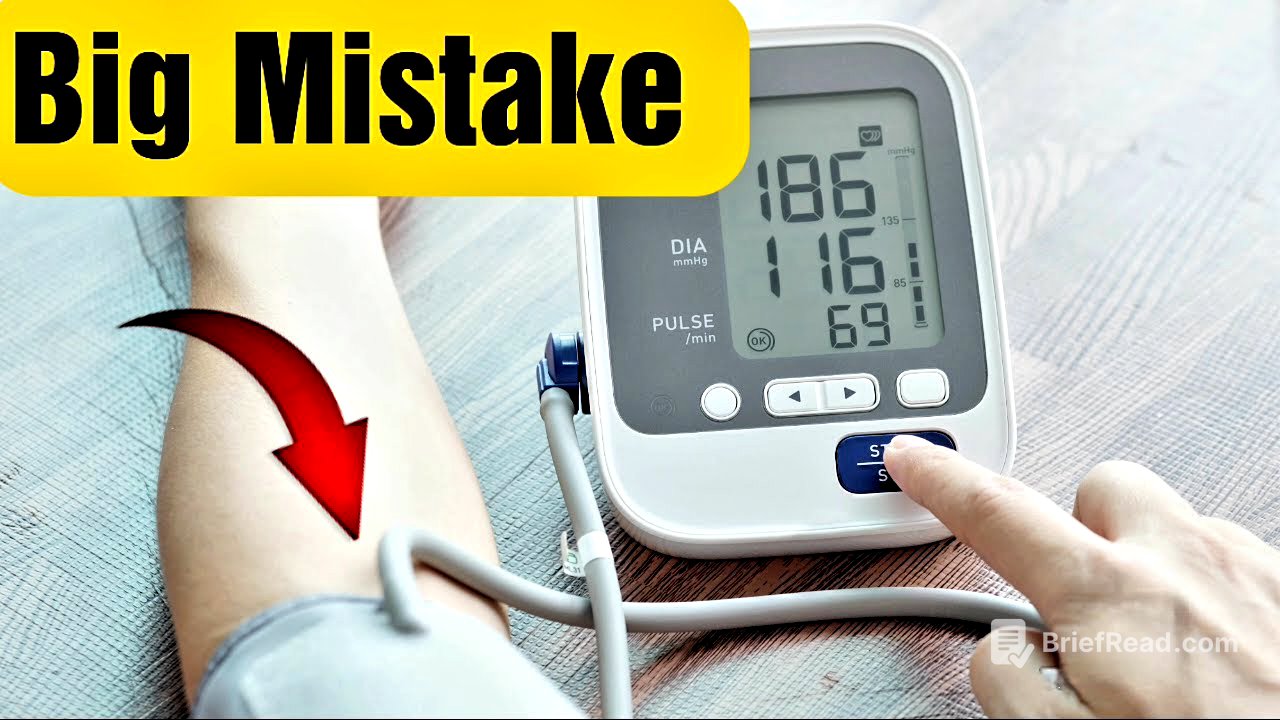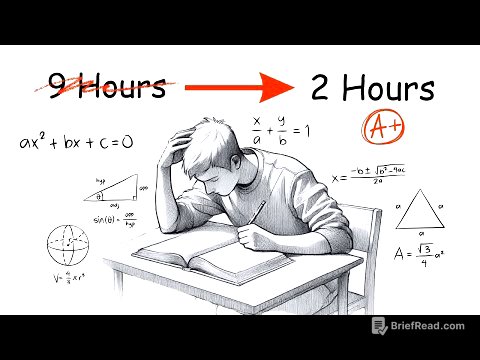TLDR;
This video explains ten common mistakes people make when checking their blood pressure at home, which can lead to inaccurate readings and potential misdiagnosis. These mistakes include placing the cuff over clothing, not positioning the arm at heart level, crossing legs, talking during the check, having an unsupported back, using a cuff that is too tight, not resting beforehand, having a full bladder, consuming caffeine or smoking, and relying on a single measurement for diagnosis. Avoiding these errors ensures more precise readings, aiding in informed healthcare decisions.
- Placing cuff over clothing interferes with accurate measurement.
- Arm should be at heart level to avoid hydrostatic pressure influence.
- Crossing legs alters blood flow and affects readings.
- Talking induces stress and muscle tension, impacting accuracy.
- Unsupported back affects posture and hemodynamic balance.
- Cuff should fit snugly, not too tight.
- Resting allows heart rate and blood pressure to return to baseline.
- Full bladder creates discomfort and stimulates the nervous system.
- Caffeine and smoking elevate blood pressure temporarily.
- Relying on a single measurement can lead to misdiagnosis.
Placing Cuff Over Clothing [0:27]
Placing the blood pressure cuff over clothing is a common mistake that leads to inaccurate readings. Clothing acts as a physical barrier, preventing direct contact between the cuff and the skin, which interferes with the cuff's ability to properly detect and measure blood pressure. This barrier can cause the cuff to inflate improperly or distribute pressure unevenly, resulting in inaccurate measurements. To ensure an accurate reading, it is essential to place the cuff directly on the bare skin of your upper arm, allowing it to inflate and deflate correctly while applying even pressure.
Arm Not Being at Heart Level [1:41]
Taking a blood pressure reading when the arm is not at heart level leads to inaccurate measurements due to hydrostatic pressure. When the arm is below heart level, gravity increases the pressure in the arm, resulting in a falsely elevated reading, potentially leading to a misdiagnosis of hypertension. Conversely, if the arm is above heart level, the reading will be artificially lowered, which might result in undiagnosed or underestimated blood pressure levels. For accurate readings, position the arm at heart level, ensuring the middle of the cuff is at the same height as the heart.
Leg Crossing [3:07]
Crossing the legs while taking blood pressure measurements can lead to inaccurate readings because it alters blood flow and circulation. When the legs are crossed, especially at the knees, it can impede blood flow from the legs back to the heart, potentially causing a temporary increase in blood pressure. As a result, the blood pressure reading may be higher than it would be if the legs were uncrossed. To ensure the most accurate blood pressure measurement, avoid crossing the legs and maintain a relaxed, neutral position during the assessment.
Conversing While Undergoing During the Check [4:27]
Talking during a blood pressure check can influence blood pressure readings in various ways. Engaging in conversation can trigger stress or anxiety responses, causing a temporary increase in blood pressure levels, leading to higher readings than the individual's actual baseline. Conversation may also induce muscle tension and altered breathing patterns, affecting blood flow and arterial constriction, further impacting the accuracy of measurements. Maintaining a calm, quiet environment is important for accurate readings.
Unsupported Back [5:27]
Having an unsupported back during blood pressure measurement can significantly impact the readings. When individuals sit with an unsupported back, they often slump forward, increasing pressure on the abdomen and chest. This compression can hinder lung expansion and reduce thoracic volume, requiring the heart to exert more force to pump blood against heightened vascular resistance. Ensuring proper posture with adequate back support is crucial for obtaining reliable blood pressure readings.
Cuff Too Tight [6:41]
When the cuff is too tight during a blood pressure measurement, it can give a falsely high reading. An overly tight cuff squeezes the arm too much, making it harder for blood to flow through the arteries, resulting in an artificially high blood pressure reading. The cuff should fit snugly around your upper arm but not too tight; you should be able to fit one finger between the cuff and your arm.
Should Be at Rest [7:24]
Resting for 5-10 minutes before taking a blood pressure reading is crucial for ensuring accuracy. This rest period allows the heart rate and blood pressure to return to their baseline levels after any physical activity, as even mild movements can temporarily elevate these parameters. Sitting quietly decreases sympathetic nervous system activity, reducing transient increases in blood pressure. Resting also helps mitigate white coat hypertension, where anxiety in clinical settings temporarily elevates blood pressure.
Full Bladder [8:32]
Checking blood pressure with a full bladder can significantly affect the reading, leading to elevated results. A full bladder creates discomfort and physical stress in the body, triggering a physiological response that can temporarily increase blood pressure. The distended bladder stimulates the sympathetic nervous system, causing a rise in blood pressure. To ensure accurate and reliable blood pressure measurements, it is recommended to empty the bladder before taking a reading.
Taking Caffeine or Smoking [9:28]
Consuming caffeine and smoking before taking a blood pressure measurement can significantly affect the results, leading to elevated readings. Caffeine stimulates the cardiovascular system, causing a temporary increase in heart rate and blood pressure, while smoking causes a spike in blood pressure due to nicotine's stimulation of the nervous system. To obtain accurate blood pressure readings, it is recommended to wait at least 30 minutes after consuming caffeine or smoking before taking the measurement.
One Taker H1 Diagnosis Method [10:40]
Relying on a single blood pressure measurement to diagnose hypertension is inadequate because blood pressure can fluctuate due to various factors. An elevated reading at one moment may not accurately reflect a person's usual blood pressure, leading to a potential misdiagnosis. A more accurate approach involves taking multiple measurements at each visit, separated by a few minutes, and using their average. This process should be repeated across several visits to account for temporary fluctuations.









